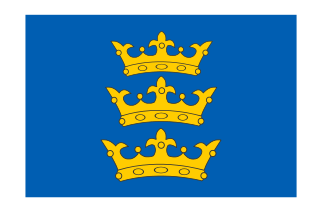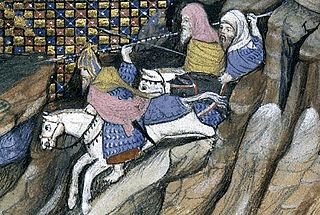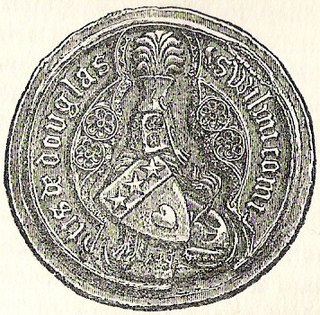| |||||
| Centuries: | |||||
|---|---|---|---|---|---|
| Decades: | |||||
| See also: | Other events of 1357 List of years in Ireland | ||||
Events from the year 1357 in Ireland.
| |||||
| Centuries: | |||||
|---|---|---|---|---|---|
| Decades: | |||||
| See also: | Other events of 1357 List of years in Ireland | ||||
Events from the year 1357 in Ireland.

The Wars of Scottish Independence were a series of military campaigns fought between the Kingdom of Scotland and the Kingdom of England in the late 13th and early 14th centuries.

The Lordship of Ireland, sometimes referred to retroactively as Norman Ireland, was the part of Ireland ruled by the King of England and controlled by loyal Anglo-Norman lords between 1177 and 1542. The lordship was created following the Norman invasion of Ireland in 1169–1171. It was a papal fief, granted to the Plantagenet kings of England by the Holy See, via Laudabiliter. As the Lord of Ireland was also the King of England, he was represented locally by a governor, variously known as the Justiciar, Lieutenant, Lord Lieutenant or Lord Deputy.

William Henry Cavendish Cavendish-Bentinck, 3rd Duke of Portland, was a British Whig and then a Tory politician during the late Georgian era. He served as Chancellor of the University of Oxford (1792–1809) and twice as Prime Minister of Great Britain (1783) and then of the United Kingdom (1807–1809). The gap of 26 years between his two terms as Prime Minister is the longest of any British Prime Minister. He was also the fourth great-grandfather of King Charles III through his great-granddaughter Cecilia Bowes-Lyon, Countess of Strathmore and Kinghorne.
The Lord High Chancellor of Ireland was the highest judicial office in Ireland until the establishment of the Irish Free State in 1922. From 1721 to 1801, it was also the highest political office of the Irish Parliament: the Chancellor was Speaker of the Irish House of Lords. The Lord Chancellor was also Lord Keeper of the Great Seal of Ireland. In all three respects, the office mirrored the Lord High Chancellor of Great Britain.

Art Óg Mac Murchadha Caomhánach was an Irish king who is generally regarded as the most formidable of the later kings of Leinster. He revived not only the royal family's prerogatives, but also their lands and power. During his 42-year reign, he dominated the Anglo-Norman settlers of Leinster. His dominance of the province and its inhabitants, both Gaelic and Hiberno-Norman, was deemed sufficiently detrimental to the colony that Richard II of England spent much of the years 1394 and 1395 sparring with him. While MacMurrough-Kavanagh did eventually submit to Richard, he renounced this fealty on Richard's departure and made much of his kingdom a death trap for any invading English or Anglo-Irish forces. The Crown accordingly dealt with him cautiously and he was granted an amnesty in 1409.

The black cap is a plain black fabric square formerly worn as symbolic headgear by English, Welsh, Irish and Northern Irish judges in criminal cases when passing a sentence of death. When worn, the square was placed on top of the judicial wig, with one of the four corners of the fabric facing forward. The cap is based on Tudor court styles.

William Douglas, 1st Earl of Douglas was a Scottish nobleman, peer, magnate, and head of the Black Douglas family. Under his leadership, the Black Douglases continued their climb to pre-eminence in Scottish politics begun under his uncle, Sir James the Good, as well as their military dominance of the south of Scotland.
Trim was a constituency and rotten borough in Trim, County Meath, represented in the Irish House of Commons until 1800.

Colonel The Honourable John Edmund Erskine, of Cardross, was a Scottish soldier and politician. His journal was printed in the nineteenth century. He was nicknamed The Black Colonel.

Edward le Despenser, 1st Baron Despenser was the son of another Edward le Despenser and Anne Ferrers, sister of Henry, Lord Ferrers of Groby. He succeeded as Lord of Glamorgan in 1349.
Events from the year 1349 in Ireland.
Sir Richard Redman was an English nobleman, knight, administrator and politician, being elected as a Member of Parliament representing Yorkshire and later acting as the Speaker of the House of Commons for the Parliament of 1415.

Sir Philip Courtenay, of Powderham, Devon was the fifth son of Hugh Courtenay, 10th Earl of Devon (1303–1377). He was the founder of the cadet dynasty known as "Courtenay of Powderham", seated at the manor of Powderham, until then a former Bohun manor of little importance, whilst the line descended from his elder brother, the Earls of Devon of the mediaeval era, continued to be seated at Tiverton Castle and Okehampton.
Sir Elias de Asshebournham, or Ellis de Ashbourne (c.1290-1357/8) was an Irish judge who held the office of Lord Chief Justice of Ireland, and fought a long battle with a rival candidate, Thomas Louth, to retain it. Despite frequent allegations of corruption, for many years he retained the confidence of the English Crown.

Henry de Motlowe was an English-born judge who briefly held office as Lord Chief Justice of Ireland.
John le Hunt, or Hunter was an English-born judge who served briefly as Lord Chief Justice of Ireland. He was the ancestor of the prominent Longueville family of Wolverton.

Sir William de Notton, or Norton was an English landowner and judge, who had a highly successful career in both England and Ireland, culminating in his appointment as Lord Chief Justice of Ireland in 1361.
Richard de Wirkeley was an English-born cleric who was Prior of the Order of Hospitallers in Ireland and held office very briefly as Lord Chief Justice of Ireland.

William Montagu, 2nd Earl of Salisbury, 4th Baron Montagu, King of Mann, KG was an English nobleman and commander in the English army during King Edward III's French campaigns in the Hundred Years War. He was one of the Founder Knights of the Order of the Garter.